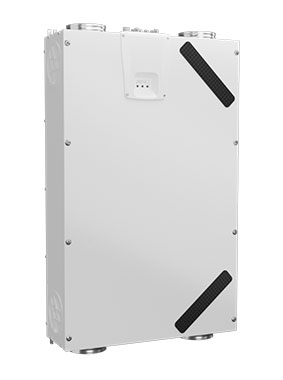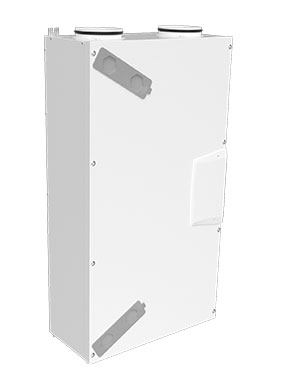Health and well-being, value retention, and energy saving – there are many reasons in favour of controlled residential ventilation. In your own four walls, it ensures constantly high air quality and optimum humidity with a regular air exchange. Controlled residential ventilation ensures the necessary air exchange between inside and outside air. This regular air exchange not only benefits the residents, but also the fabric of the building.
Best of SHK Award. x-well residential ventilation won the “Best of SHK Award 2020” in the air conditioning/ventilation category. The winners are chosen every year by the readers of the trade magazine “Si”, i.e. by the SHK specialist tradesmen – those who work with the products on a daily basis. With a circulation of over 50000 copies, the German trade journal “Si” is one of the most renowned trade journals on the German market.

Used air has a higher proportion of carbon dioxide than fresh air and its oxygen content is significantly lower that that of fresh air. Used air is also considerably more humid than fresh air. With controlled residential ventilation, ventilation units transport used air and therefore CO2 and moisture using fans through air ducts from inside to outside and feed fresh outside air into the room. A heat exchanger in the ventilation duct transfers heat from the extract air back into the fresh supply air, so that virtually no heat (and therefore energy) is lost. Windows can remain closed and pollutants remain outside. The display integrated in the ventilation unit enables complete monitoring in addition to simple operation.
Central residential ventilation units are the ideal choice for passive houses, low energy houses, and for buildings modernised for energy efficiency. Apart from the ventilation ducts, there is a central fan which removes humid and used air and introduces heated supply air into the room. The system can be easily controlled using a self-explanatory controller. The humidity sensors installed ensure that the ventilation system is really only on when you need it. This not only effectively reduces energy consumption, but also any operating noises which may arise. Is a ventilation system loud or very visible? All x-well compact ventilation units are low-noise. Depending on the operating level – not at all to barely audible. The functional external covers in white, anthracite, or stainless steel not only fit unobtrusively into the external look of your property, but also ensure there is optimal sound insulation or damping from external noises. Inside your rooms, the x-well design air vents are the ideal solution for a range of different installation solutions.
x-well S-series: compact ventilation units for new-builds.

x-well S180 / S180 E
Suitable for apartments and houses with up to approx. 125 m² floor space .

x-well S280 / S280 E
Suitable for apartments and houses with up to approx. 175 m² floor space .

x-well S370 / S370 E
Suitable for apartments and houses with up to approx. 240 m² floor space .

x-well S460 / S460 E
Suitable for apartments and houses with up to approx. 350 m² floor space .
x-well F-series: central residential ventilation which can also be retrofitted.

x-well F150
Suitable for apartments and houses with up to approx. 105 m² floor space .

x-well F170 / F170 E
Suitable for apartments and houses with up to approx. 120 m² floor space.

x-well F270
Suitable for apartments and houses with up to approx. 210 m² floor space.
Decentralised residental ventilation
Regardless of whether as a complete system for new-builds or for retrofitting during the renovation of a house. With decentralised residential ventilation individual rooms can be ventilated individually, especially the kitchen, bathroom, and toilet. A basic distinction is made between three device categories. Pendulum fans: Perfect for permanent ventilation of rooms. Alternately, fresh air is drawn in from outside and extract air is transported out. In the Kermi systems with heat recovery, the extract air gives off heat to the heat exchanger, which then heats the fresh air again. Single-pipe fans / small room fans: They are designed for use in extract air spaces and depending on user, reliably convey used and humid air to the outside, for example from the bathroom or WC. Outer wall air vents: They ensure a natural supply air replenishment in decentralised systems, ideal when combined with single-pipe fans and small room fans. For installation, a wall opening in the outer wall is required for each fan and the associated cable connection. The installation brick makes it quicker and easier to install in a new-build.
Pendulum fan

x-well D13

x-well D12

x-well D11
Why controlled residental ventilation?
Intelligent residential ventilation plays a really key role on energy-efficient building planning and during refurbishment of old buildings for energy efficiency. If sufficient ventilation is not guaranteed as well as adequate heating of living space, then there is literally a “bad atmosphere” in your own four walls. Bacteria and mould in contrast feel even more at home in used, humid air.
Particularly in modern, energy saving homes today, it is virtually impossible for natural air exchange to take place. Joints and windows are perfectly sealed and prevent natural air exchange. That is why, according to Section 6 of the energy saving ordinance (EnEV), for new buildings, the building envelope not only has to be “permanently impermeable to air and sealed in accordance with recognised rules of technology”, it also has to be designed so “that the minimum air exchange required for health and heating purposes is ensured”.
Even if you tilt the window open for a long time or carry out short, intense ventilation, the minimum air exchange is not reached. Ventilating for several hours with the window open is particularly a problem for those out at work and during cold weather, leads to high energy losses. Even when you are on holiday, regular air exchange must be ensured to continuously transport moisture out and avoid the formation of mould.

Against humid, bad air
With Kermi, moisture, too much CO2, and environmental pollution are forced to stay outside. Kermi x-well ventilation units filter the room air fully automatically and ensure consistently pleasant, hygienic thermal comfort – which of course is also energy-efficient. A wide variety of filter inserts ensure that even allergy sufferers feel comfortable again in their own home.
Energy efficient & flexible
All Kermi x-well ventilation units are impressive with high energy efficiency and are suitable for apartments and houses with up to approx. 350 m floor space2 floor space.
For new-builds & renovation
Both new-builds and refurbishment projects can be fitted with Kermi x-well. For property developers that means: increased living comfort due to improved air circulation and energy savings thanks to intelligent ventilation.
The benefits of x-well residental ventilation:
Maintains value and minimises the risk of mould
Kermi x-well ventilation devices will ensure a better living climate by reliably transporting away used air. That is not just a plus for quality of life, but actively reduces the risk of a mould infestation. As your property is less susceptible to mould thanks to controlled ventilation, Kermi x-well also contributes towards maintaining the value of your property and avoids unnecessary structural damage.
Saves energy and therefore heating costs
A ventilation system is considerably more efficient than windows left open in an uncontrolled manner, as an intelligent or controlled air and heat exchange takes place. In comparison to old-fashioned window airing, controlled residential ventilation reduces heat losses. Your thermal comfort remains consistently pleasant. That is not only good for your health and for the environment, it is also good for your wallet.
More comfort and quality of life
Not necessary to manually open and close windows. That means that less noise from outside and environmental pollution will get into your home. Leaving windows open is a thing of the past – a plus for security.
Clean air and pleasant thermal comfort
Kermi x-well air filters or pollen filters ensure that the air is clean, reliably filtering particles out of the air (particularly in city apartments and along main roads) and pollen. This means a pleasant climate, particularly for people with allergies.
Low running costs and extremely easy maintenance
Kermi x-well ventilation devices feature having low running costs and are extremely easy to maintain. Only regular maintenance guarantees economic operation and a longer service life of your ventilation system. This includes checking supply and exhaust air vents for dirt and cleaning them as required. Every 24 months, the system should be serviced by a specialist who will thoroughly check your Kermi x-well residental ventilation system.
Is it possible to retrofit a ventilation system?
Yes. When refurbishing older properties, it is often possible to attain such a level of insulation that controlled residental ventilation is essential. Here, there are two integration solutions for retrospective installation of ventilation systems.
Kermi x-well residental ventilation – laid in the suspended ceiling
Integration in a suspended ceiling
Integration in a suspended ceiling as a decentralised ventilation system is possible if there is enough ceiling height available in the living space. A compact ventilation unit like the Kermi x-well F170 is particularly suitable for this due to its flat design. However, it does not have to be integrated in the ceiling, but can also be mounted vertically, e.g. hidden in kitchen or bathroom cabinets.
Integration in the floor structure
As an alternative, if for example the ceiling is not high enough, then your ventilation system can also be integrated in the floor structure. With this solution, ventilation ducts are installed in the insulation level which allows central living room ventilation.


